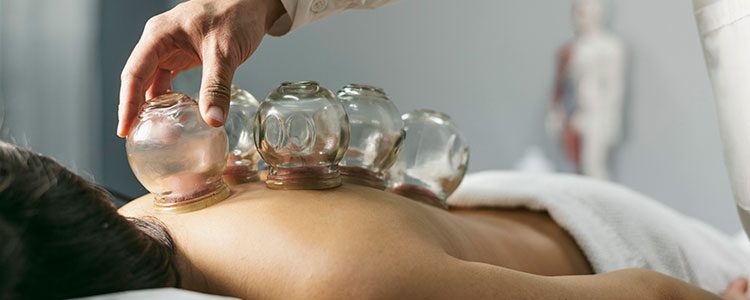Can Cupping Therapy Help With Your Pain?

Why is cupping so popular amongst PTs these days?
Cupping therapy is on the rise in Physical Therapy clinics, and for a good reason! Cupping is an evidence-based technique that can be used to help manage a range of chronic pain conditions and acute injuries, from back pain and carpal tunnel syndrome, to soft tissue strains and arthritis.
You may have seen pictures of athletes or celebrities with the dark circles on their backs characteristic of cupping, or perhaps you are familiar with cupping to help with the flow of Qi from a Traditional Chinese Medical perspective. But, why is cupping so popular amongst PTs these days?
What is Cupping Therapy?
Cupping involves placing specialized ‘cups’ (commonly made of silicone or plastic) with a suction mechanism onto the skin. The suction mechanism is used to create a pressurized environment underneath the cup.
Scientific studies have found that the skin and soft tissues (muscle, fascia, and connective tissues) under the cup are gently lifted and stretched, and importantly, blood vessels dilate, causing increased blood flow. The mobilization of soft tissues and improved blood circulation—similar to massage therapies—promotes oxygenated and nutrient-rich blood into the area, which is beneficial for pain relief and healing.
The Development of Cupping Therapy
The therapeutic origins of cupping therapy extend back many thousands of years to cultures as diverse as China and East Asia, the Middle East, and Egypt. Slight variations are documented, from the types of cups used to what conditions are treated, however, what unites the ancient and contemporary use of cupping is the positive therapeutic effects patients experience!
The development of cupping in contemporary PT practices emphasizes it as a treatment for acute injuries, e.g. muscle and tissue sprains, and ongoing chronic conditions, such as long-lasting back pain and headaches.
As well as increasing blood flow to the area, the effectiveness of cupping in a PT clinic is evaluated by the way it targets and mobilizes soft tissues, particularly tissues that are tight or have decreased movement. Sometimes cupping is referred to as myofascial decompression (MFD), as the suction mechanism of the cups helps decompress soft tissue and improve blood flow. This is particularly beneficial for athletes to help with their muscle recovery and people who experience chronic tightness.
Types of Cupping Therapy
There are a variety of cupping techniques, but at SOPTRI, we use dry and wet cupping.
Dry cupping involves placing the suction cups on the skin of the area of the body to be treated (e.g. the back, hamstrings, etc).
Your PT may just let the cups sit for a few minutes. However, often, they will combine the use of cups with active movements, like stretching. They may also gently wiggle the cups over the skin, which helps with myofascial and scar tissue mobility.
Wet cupping starts the same as dry cupping. However, your PT will provide oil and/or lotion underneath the cups, which allows them to glide and massage the area. This helps to provide myofascial release and improve circulation to an area that might feel tight or restricted.
Does Cupping Therapy Hurt?
This is a common question, given the bruise-like marks cupping can leave behind — but the answer is no! You may be aware of a suction-like feeling, but that’s about it.
Many people experience improved mobility and pain relief almost immediately. Some people may have slight stiffness the following day (similar to a deep tissue massage) but improved relief later on.
The marks left from the cups are largely superficial, they won’t be tender like bruised tissue. Typically any marks left will dissipate after 1-3 days.
Conditions Cupping Therapy Can Help With
Cupping therapy has been shown to be effective in the treatment of:
- Headaches and migraines
- Neurological conditions, such as facial paralysis and brachialgia
- Rheumatoid and Osteoarthritis
- Chronic pain conditions, such as fibromyalgia
From a scientific perspective, the physiological mechanisms and effects of cupping are an evolving field. Often, its beneficial effects cannot be fully explained. However, positive effects for improved mobility, pain management, and general improved wellbeing are commonly reported and observed.
How Your PT Might Use Cupping Therapy
Your PT will give you a thorough assessment to determine if cupping therapy may benefit you. Cupping therapy is often used alongside other treatment modalities, such as massage and tissue manipulation, dry needling, and recommended exercises.
Get in touch today to book an appointment with one of our experienced PTs and see if cupping can help you.
–
Author: Sylvie Le, DPT, PYTC
